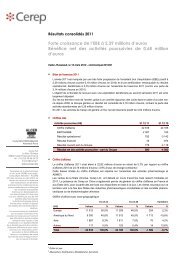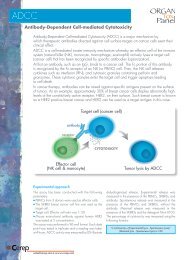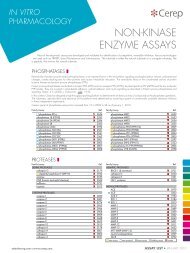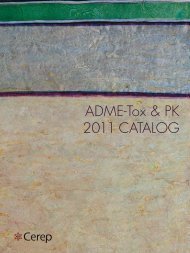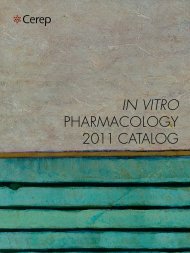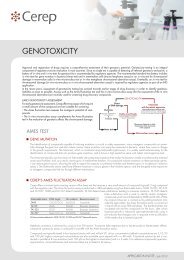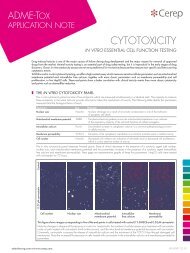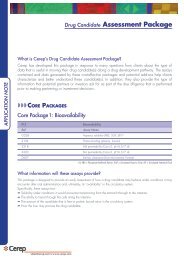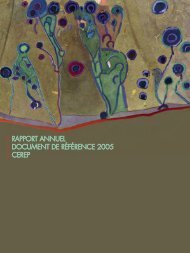In vitroTox - Cerep
In vitroTox - Cerep
In vitroTox - Cerep
Create successful ePaper yourself
Turn your PDF publications into a flip-book with our unique Google optimized e-Paper software.
ADR panel<br />
Identifying Potential Adverse<br />
10<br />
Drug Reactions (ADRs) 9<br />
<strong>Cerep</strong>’s ADR Panels offer a client the ability to focus on<br />
specific body systems suggested by results seen in their<br />
preclinical or clinical studies. <strong>Cerep</strong>’s unique experience<br />
with pharmacological screening of drugs and other<br />
reference compounds has allowed to offer small<br />
affordable panels of assays that cover serious ADRs that<br />
are either directly or statistically associated with different<br />
body systems.<br />
ADR Profiles by Body System<br />
pIC 50<br />
8<br />
7<br />
6<br />
5<br />
4<br />
3<br />
Restlessness, lethargy<br />
Depression, Gi disorder<br />
Ataxia, amnesia, agitation<br />
ASSAYS<br />
Figure 1. ADRs associated with a test compound’s individual<br />
pharmacology assay hits.<br />
Many drug ADRs are linked to off-target activities at a great variety of cellular receptors and enzymes. <strong>Cerep</strong> has created a series<br />
of assay profiles, each oriented to the ADRs of six specific body systems: Blood, Liver, Kidney, CNS, Cardiovascular and Lung.<br />
The targets are chosen for each profile on the basis of statistical associations derived from <strong>Cerep</strong>’s proprietary BioPrint ® and from<br />
available ADR databases.<br />
Table 1. List of targets for 6 organ systems<br />
Cyst<br />
Blood<br />
CNS<br />
CV<br />
Kidney<br />
Liver<br />
Lung<br />
Assay Name<br />
Ref.<br />
5-HT transporter 0439 l l l<br />
5-HT1A 0131 l<br />
5-HT1B 0132 l<br />
5-HT2A 0471 l l l<br />
5-HT2B 1333 l<br />
5-HT2C 1003 l l l<br />
5-HT3 0411 l<br />
5-HT4e 0501 l<br />
5-HT7 0144 l<br />
A2B 0005 l<br />
A3 0006 l<br />
ACE 3441 l l l l l<br />
acetylcholinesterase 0363 l l l l<br />
adenylyl cyclase 3002 l l l<br />
alpha1A 2338 l l<br />
alpha2A 1669 l l<br />
alpha2B 1344 l l l l<br />
alpha2C 1682 l<br />
AR 0933 l l l<br />
AT1 0024 l<br />
ATPase (Na+/K+) 2009 l l<br />
beta1 0018 l l l<br />
beta2 0020 l l<br />
BZD (central) 0028 l<br />
Ca2+ L (diltiazem site) 0162 l<br />
carbonic anhydrase II 2572 l l<br />
CB1 0036 l<br />
Cl- channel (GABA-gated) 0170 l<br />
constitutive NOS (endothelial) 0197 l<br />
COX2 0727 l l l l l<br />
D1 0044 l l l<br />
D2S 1322 l<br />
D2S 1322 l<br />
D3 0048 l<br />
D4.4 0049 l l l<br />
delta2 (DOP) 0114 l l<br />
dipeptidyl peptidase IV (DPP-IV) 2942 l<br />
dopamine transporter 0052 l<br />
sales@cerep.com l www.cerep.com<br />
Blood<br />
CNS<br />
CV<br />
Kidney<br />
Liver<br />
Lung<br />
Assay Name<br />
Ref.<br />
elastase 0183 l<br />
ERa 0484 l l l<br />
ERK2 (P42mapk) 2878 l<br />
ETB 0056 l<br />
FLT-1 kinase (VEGFR1) 3068 l<br />
FP 1979 l<br />
GABA transaminase 0461 l<br />
GABA transporter 0060 l<br />
GABAA1 (a1,b2,γ2) 3051 l<br />
GR 0469 l<br />
GSK3a 2842 l l<br />
H1 0870 l l<br />
H2 1208 l l l l<br />
hERG (membrane preparation) 1868 l<br />
kappa (KOP) 1971 l<br />
M2 0093 l l l<br />
M4 0096 l<br />
M5 0097 l l<br />
MAO-A 0443 l l l<br />
motilin 0470 l l<br />
MT3 (ML2) 0088 l l l<br />
mu (MOP) 0118 l<br />
N muscle-type 0936 l<br />
Na+ site 2 0169 l l l l l<br />
NK2 0102 l l<br />
NMDA 0066 l l l<br />
norepinephrine transporter 0355 l l<br />
PCP 0124 l<br />
PDE3A 2432 l<br />
PLC 2837 l<br />
PTH1 2660 l<br />
sigma (non-selective) 3500 l<br />
SKCa 0167 l l<br />
TNF-a 0076 l l<br />
TP (TXA2/PGH2) 0001 l l<br />
tyrosine hydroxylase 0214 l l<br />
UT 1386 l l<br />
<strong>In</strong> vitro Tox
ADR panel<br />
Table 2. List of serious ADR drug for 6 organ systems<br />
CNS<br />
Asthenia<br />
Ataxia<br />
Cholinergic toxicity<br />
Coma<br />
Confusion<br />
Convulsion<br />
Depression<br />
Emesis<br />
Extrapyramidal symptoms<br />
Hyperpyrexia<br />
Hypomotility<br />
Nausea<br />
Neuroleptic malignant<br />
syndrome<br />
Neurotoxicity neuropathy<br />
Parkinsonism<br />
Sedation<br />
Seizures<br />
Tardive dyskinesia<br />
Tremors<br />
Vertigo<br />
CV<br />
Atrioventricular block<br />
Bradycardia<br />
Cardiac arrest<br />
Cardiac failure<br />
Cerebrovascular dysfunction<br />
Congestive heart failure<br />
Coronary vascular damage<br />
Dysrhythmias<br />
Heart block<br />
Hypertension<br />
Hypotension<br />
Ischemia<br />
Myocardial damage<br />
Myocardial infarction<br />
Sudden cardiac death<br />
Tachycardia<br />
Torsade de pointes<br />
Vasoconstriction<br />
Ventricular arrhythmias<br />
LIVER<br />
LUNG<br />
Cholestasis<br />
Hepatic and hepatobiliary<br />
disorders<br />
Hepatitis<br />
Hepatocellular damage<br />
Hepatopulmonary syndrome<br />
Hepatotoxicity<br />
Jaundice<br />
Airway hyperreactivity<br />
Bronchial disorders<br />
Fibrosis<br />
Granulocyte infiltration<br />
<strong>In</strong>terstitial pneumonia<br />
Thromboembolism<br />
Vascular pulmonary disorders<br />
BLOOD<br />
KIDNEY<br />
Anemia<br />
Azotemia<br />
Bilirubinemia<br />
Blood autoimmune disorders<br />
Blood dyscrasia<br />
Hematuria<br />
Hemolytic anemia<br />
Hyperbilirubinaemia<br />
Neutropenia<br />
Peripheral ischemia<br />
Platelet aggregation<br />
Porphyria<br />
Red blood cell disorder<br />
Uremia<br />
Diabetic complications<br />
Kidney failure<br />
Nephrotoxicity<br />
Protein present in urine<br />
Renal dysfunction<br />
Urinary tract disorder<br />
Panel Design<br />
➥ Known association of individual targets with serious ADRs<br />
l ADR Databases: DART 1&2 and DITOP 3&4 – Identification of targets already known to be linked to specific ADRs<br />
l Literature – Assay selection based on literature reviewing the mechanisms of action for individual ADRs<br />
➥ Statistical association of individual targets with serious ADRs using information from <strong>Cerep</strong>’s proprietary BioPrint ® Database<br />
l Using BioPrint ® , targets are selected based on statistical associations between individual targets and individual ADRs.<br />
Chi-square analysis was performed to identify statistically significant correlations in a matrix of >150 assays by >800 ADR terms 5 .<br />
Over 5,000 significant in vitro assay-ADR associations were found covering over 100 assays. Close examination of this set of<br />
associations yields many results that are consistent with known pharmacology and many others that appear to be novel.<br />
Figure 2. M3 and “abnormal visual accommodation”<br />
IC 50<br />
BinRange (nM) / BinHits<br />
ADR negative ADR positive Baseline<br />
0 to 99 (n=26)<br />
100 to 499 (n=14)<br />
500 to 999 (n=14)<br />
1,000 to 4,999 (n=32)<br />
5,000 to 9,999 (n=22)<br />
10,000 to 49,999 (n=41)<br />
50,000+ (n=894)<br />
-100 -75 -50 -25 0 25 50 75 100<br />
Percentage of hits<br />
Figure 2 shows the significant statistical association between<br />
in vitro binding to the M3 muscarinic receptor and<br />
the in vivo ADR “abnormal visual accommodation”. Seven<br />
IC 50 activity bins are found on the y-axis ranging from the<br />
0-99 nM bin to the greater-than-50,000 nM bin which is<br />
the default bin for the non-hits. The number of compounds<br />
in each bin is indicated. The blue and red bars shown with<br />
each bin represent the percentage of compounds in that<br />
bin that are positive (blue) or negative (red) for the ADR in<br />
question. This figure illustrates the association of “abnormal<br />
visual accommodation” with the M3 muscarinic receptor.<br />
The baseline frequency of this ADR is 6.44% while nearly<br />
half of the drugs with M3 hits in the



